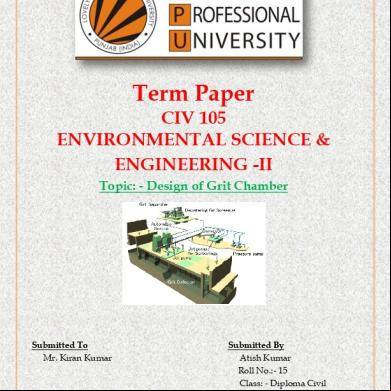Requirements Of Good Ballast 4m3r2i
This document was ed by and they confirmed that they have the permission to share it. If you are author or own the copyright of this book, please report to us by using this report form. Report 445h4w
Overview 1s532p
& View Requirements Of Good Ballast as PDF for free.
More details 6h715l
- Words: 450
- Pages: 6
Term Paper CIV 040 Elements of Railway Engineering Topic: - Requirements of Good Ballast
Submitted To Mr. Amit Dhir
Submitted By Atish Kumar Roll No.:- 15 Class: - Diploma Civil Semester: - 6th
CONTENTS S.N.
Description
Page No.
1.
Ballast
3
2.
Requirement of Good Ballast
4
3.
Reference
6
-2-
Ballast Track ballast forms the track bed upon which railway sleepers or railroad ties are laid. It is packed between, below, and around the ties. It is used to facilitate drainage of water, to distribute the load from the railroad ties, and also to keep down vegetation that might interfere with the track structure. This also serves to hold the track in place as the trains roll by. It is typically made of crushed stone, although ballast has sometimes consisted of other, less suitable materials.
Ballast
-3-
Requirement of Good Ballast 1.
The ballast should be clean and graded crushed stone aggregate with hard, dense, angular particle structure providing sharp corners and cubical fragments with a minimum of flat and elongated pieces. These qualities will provide for proper drainage of the ballast section. The angular property will provide interlocking qualities which will grip the sleeper firmly to prevent movement. Excess flat and elongated particles could restrict proper consolidation of the ballast section.
2.
The ballast must have high wear and abrasive qualities to withstand the impact of traffic loads without excessive degradation. Excessive abrasion loss of an aggregate will result in reduction of particle size, fouling of the ballast section, reduction of drainage and loss of ing strength of the ballast section.
3.
The ballast particles should have high internal shearing strength to have high stability.
4.
The ballast material should possess sufficient unit weight to provide a stable ballast section and in turn provide and alignment stability to the track structure.
5.
The ballast should provide high resistance to temperature changes, chemical attack, exhibit a high electrical resistance and low absorption properties.
-4-
6.
Ballast material should be free from cementing properties. Deterioration of the ballast particles should not induce cementing together of the degraded particles.
7.
The ballast material should have less absorption of water as excessive absorption can result in rapid deterioration during alternate wetting and drying cycles.
8.
The ballast gradation should be such that it allows development of necessary compressive strength, meet density requirements of the ballast section, uniform , elasticity and provide necessary void space to allow proper runoff of ground water. It should reduce deformation of the ballast section from repeated track loadings.
9.
The Ballast should be cheap and economical.
-5-
Reference Website
http://www.american-rails.com/ballast.html http://en.wikipedia.org/wiki/Track_ballast
Book
Railway Engineering By Satish Chandra Railway Engineering By Rangwala
-6-
Submitted To Mr. Amit Dhir
Submitted By Atish Kumar Roll No.:- 15 Class: - Diploma Civil Semester: - 6th
CONTENTS S.N.
Description
Page No.
1.
Ballast
3
2.
Requirement of Good Ballast
4
3.
Reference
6
-2-
Ballast Track ballast forms the track bed upon which railway sleepers or railroad ties are laid. It is packed between, below, and around the ties. It is used to facilitate drainage of water, to distribute the load from the railroad ties, and also to keep down vegetation that might interfere with the track structure. This also serves to hold the track in place as the trains roll by. It is typically made of crushed stone, although ballast has sometimes consisted of other, less suitable materials.
Ballast
-3-
Requirement of Good Ballast 1.
The ballast should be clean and graded crushed stone aggregate with hard, dense, angular particle structure providing sharp corners and cubical fragments with a minimum of flat and elongated pieces. These qualities will provide for proper drainage of the ballast section. The angular property will provide interlocking qualities which will grip the sleeper firmly to prevent movement. Excess flat and elongated particles could restrict proper consolidation of the ballast section.
2.
The ballast must have high wear and abrasive qualities to withstand the impact of traffic loads without excessive degradation. Excessive abrasion loss of an aggregate will result in reduction of particle size, fouling of the ballast section, reduction of drainage and loss of ing strength of the ballast section.
3.
The ballast particles should have high internal shearing strength to have high stability.
4.
The ballast material should possess sufficient unit weight to provide a stable ballast section and in turn provide and alignment stability to the track structure.
5.
The ballast should provide high resistance to temperature changes, chemical attack, exhibit a high electrical resistance and low absorption properties.
-4-
6.
Ballast material should be free from cementing properties. Deterioration of the ballast particles should not induce cementing together of the degraded particles.
7.
The ballast material should have less absorption of water as excessive absorption can result in rapid deterioration during alternate wetting and drying cycles.
8.
The ballast gradation should be such that it allows development of necessary compressive strength, meet density requirements of the ballast section, uniform , elasticity and provide necessary void space to allow proper runoff of ground water. It should reduce deformation of the ballast section from repeated track loadings.
9.
The Ballast should be cheap and economical.
-5-
Reference Website
http://www.american-rails.com/ballast.html http://en.wikipedia.org/wiki/Track_ballast
Book
Railway Engineering By Satish Chandra Railway Engineering By Rangwala
-6-










